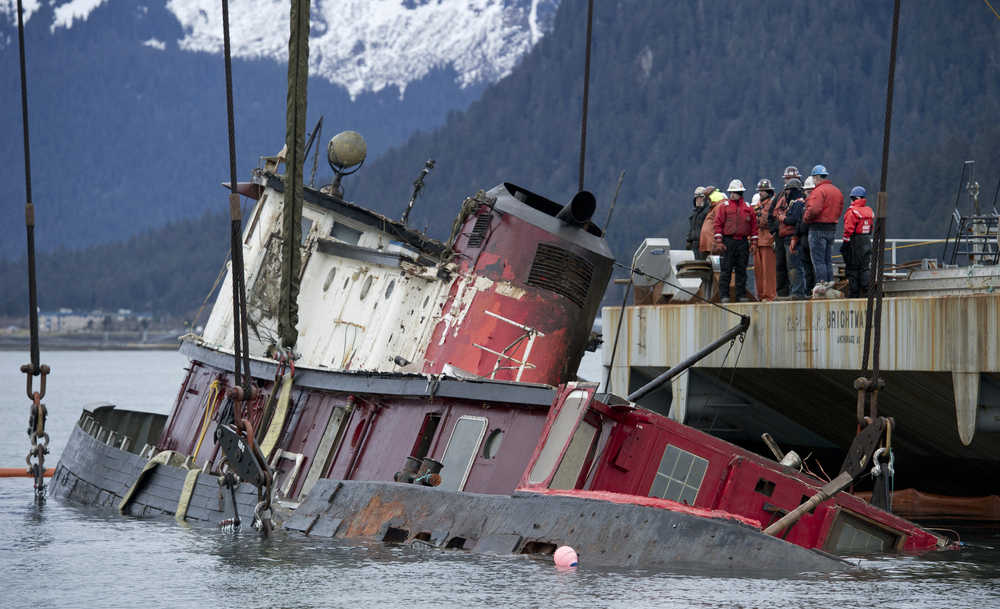It’s not easy to raise the dead.
The men and women raising the 96-foot tugboat Challenger found that out Sunday afternoon as they attempted to refloat the boat that has rested on the bottom of Gastineau Channel in Juneau since September.
While the Challenger came up, it proved too heavy to manage, so the team recovering the boat switched to Plan B. At high tide Monday (about noon), they planned to shift the Challenger to shallower water near the Douglas Island side of the channel. As the tide lowered, the Challenger was to be pumped of much of its water and otherwise lightened.
If the 72-year-old tugboat’s hull is intact, it will be refloated on the rising tide. If it’s holed — well, they’ll just have to see how bad the damage is, said Coast Guard petty officer Britany McKibben.
If the Challenger can be refloated, it will be towed to the Alaska-Juneau Mine dock to be stripped of any asbestos or hazardous material, then taken to a beach at the Rock Dump and dismantled, with much of it ending up in the Capitol Landfill.
If the Challenger can’t be refloated, it will be dismantled on a nearby beach, according to tentative plans. As for the timing of the process, “it’s almost impossible to estimate,” McKibben said.
On Sunday, until the barge-crane Brightwater (which has a capacity of 285,000 pounds) began to struggle with the Challenger, the process appeared ordinary, even boring.
For the handful of spectators on shore and aboard boats orbiting the recovery operation, there wasn’t much to see. With the action taking place beneath the surface, it was akin to watching submarine races.
“It’s a very, very slow, tedious process,” McKibben said.
More than two dozen workers were on hand. There was the Coast Guard, which controls the Oil Spill Liability Trust Fund that is paying for the effort. There was Global Diving and Salvage, which the Coast Guard hired to run the project. Turnagain Construction owns the Brightwater and was a subcontractor alongside Southeast Underwater Services and SouthEast Alaska Lightering, which were hired to corral any oil or debris that floated off the Brightwater as it came up.
Also orbiting the barge holding the Brightwater was a small boat from the U.S. Department of Agriculture, whose biologists were in charge of encouraging birds and sea life to avoid the area.
The work doesn’t come cheap: On Feb. 2, Coast Guard Cmdr. Marc Burd said about $300,000 had been spent on the Challenger so far, and the project had the authority to spend up to $900,000.
The extraordinary effort comes because the Challenger has an unknown amount of fuel and lube oil aboard, and it’s resting in a sensitive spot. Visible from the wreck site is the DIPAC hatchery, where millions of salmon fry are swimming in net pens, awaiting release across Southeast Alaska later this year.
Farther up the channel is the Mendenhall Wetlands State Game Refuge. Both areas warrant protection in the Coast Guard’s oil spill response plans, and that’s why the Challenger is getting attention while dozens of other derelict boats across Alaska are rusting away.
On Sunday afternoon, the Challenger ascended under the guidance of four slings draped from a square collection of piping and pulleys intended to balance the boat as it rose. The whole assembly dangled from the Brightwater’s towering derrick, which rose almost vertically from its parent barge. Illuminated by a handful of lights against a cloudy sky, the assembly resembled a miniature oil platform and drilling rig dropped in the middle of Gastineau Channel, just offshore of the Juneau Yacht Club.
When the Challenger emerged from the water, it didn’t look as if it had suffered much from tides and currents inflicted since its sinking. Most of its windows were still intact, and if its paint seemed worn, there have been worse paint jobs before.
Pencil-thick streams of water shot from holes in the boat’s superstructure as it emerged from the water, leaning at a 35-degree angle.
As darkness fell about 5 p.m., the Challenger was still held in the Brightwater’s slings, awaiting the next step in its resurrection.
Like all good zombie movies, however, this raising of the dead will soon be followed by a permanent end.

